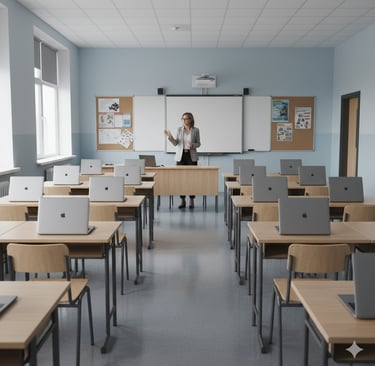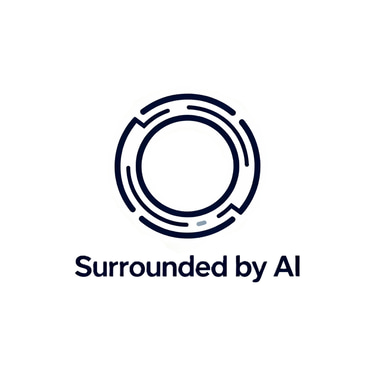The Algorithm in the Classroom
AI, Academia, and the Future of Original Thought
FUTURENEWSAPPLICATION
11/6/20255 min read


The hallowed halls of academia, once bastions of human intellect and painstaking research, are now echoing with a new voice: artificial intelligence. From high school classrooms to university lecture halls, AI tools like ChatGPT are not just knocking on the door; they've already moved in. This seismic shift heralds both unprecedented opportunities and profound challenges, particularly concerning the very essence of education: original thought. As we navigate this new landscape, it's crucial to examine the rise of AI in high school and college, and what it truly means for the cultivation of independent, critical thinking.
The ascent of AI in education has been remarkably swift. Just a few years ago, AI was largely a theoretical concept for most students. Today, large language models (LLMs) are readily accessible, capable of generating essays, solving complex problems, writing code, and even crafting poetry in mere seconds. Students are discovering these tools, sometimes with guidance, often independently, to assist with everything from brainstorming ideas to drafting entire assignments. This burgeoning reliance on AI raises fundamental questions about the role of the student, the responsibility of the educator, and the evolving definition of "original work."
The Allure of Efficiency: Pros of AI in Education
The immediate benefits of AI tools for students are undeniably attractive. At the forefront is efficiency. ChatGPT, for instance, can significantly reduce the time spent on tedious tasks. Students can quickly generate outlines, summarize lengthy texts, brainstorm ideas for essays, or even get explanations for complex concepts. This frees up valuable time that can, ideally, be redirected towards deeper understanding, critical analysis, or creative pursuits.
AI can also act as a powerful personal tutor and research assistant. Struggling with a math problem? AI can provide step-by-step solutions. Need to understand a historical event from multiple perspectives? AI can synthesize information rapidly. For students who might feel intimidated asking questions in a traditional classroom setting, AI offers a non-judgmental space to explore concepts and seek clarification at their own pace. This personalized learning experience can be particularly beneficial for students with diverse learning styles or those who require additional support.
Furthermore, AI can foster accessibility and inclusivity. Students with learning disabilities, language barriers, or physical limitations might find AI tools invaluable. Text-to-speech, translation services, and even tools that help organize thoughts can level the playing field, enabling more students to participate fully in academic life. AI can also help students refine their writing style, improve grammar, and expand their vocabulary, acting as a sophisticated writing aid that goes beyond traditional spell-checkers.
Finally, AI can be a catalyst for creativity and innovation. Far from stifling creativity, some argue that AI can liberate students from the mundane, allowing them to focus on higher-order thinking. Imagine using AI to quickly draft multiple versions of a story, then refining the plot and characters through human ingenuity. Or using AI to generate code snippets, enabling students to focus on the overarching logic and design of a program. When used thoughtfully, AI can be a springboard for exploring new ideas and pushing creative boundaries.
The Peril of Dependence: Cons and the Threat to Original Thought
Despite these promising advantages, the widespread adoption of AI in education carries significant risks, particularly concerning the erosion of original thought. The primary concern is that students might become overly reliant on AI to generate content, bypassing the crucial cognitive processes involved in genuine learning.
The most obvious pitfall is the issue of plagiarism and academic integrity. If a student submits an AI-generated essay as their own, it constitutes plagiarism, undermining the very foundation of academic honesty. While AI detection tools are evolving, so too are AI's capabilities to evade detection, creating an arms race that distracts from the core educational mission. The ease with which AI can produce coherent, albeit generic, text makes it tempting for students to choose convenience over genuine effort.
Beyond outright plagiarism, there's the more insidious threat to the development of critical thinking skills. The act of researching, synthesizing information, formulating arguments, and expressing ideas in one's own words are fundamental to intellectual growth. If AI consistently performs these tasks for students, they risk never truly developing these essential competencies. The ability to critically evaluate information, identify biases, and construct persuasive arguments is not innate; it's honed through practice and struggle. Over-reliance on AI short-circuits this vital developmental process.
The concept of "original thought" itself becomes blurred. Is an idea truly original if an AI helped to formulate it? While collaboration is a cornerstone of academic life, the nature of AI assistance can be fundamentally different. It's not a peer offering feedback or a professor guiding a student; it's an algorithm generating content. This can lead to a homogenization of ideas, where essays and analyses begin to sound remarkably similar, lacking the unique voice and perspective that characterize genuine human insight.
Furthermore, there's the risk of skill atrophy. If students consistently use AI for grammar, spelling, and sentence structure, their own writing and editing skills may decline. Similarly, if AI solves complex problems, students might not develop the problem-solving strategies and resilience that come from grappling with challenging material. This creates a generation of students who can produce polished outputs but lack the underlying mastery.
Finally, the ethical implications extend to the fairness and equity of education. If access to sophisticated AI tools becomes a differentiator, students from less privileged backgrounds who lack such access could be at a disadvantage. This could exacerbate existing inequalities, creating a digital divide in intellectual development.
Navigating the Future: Finding a Balance
The rise of AI in education is not a trend that can be ignored or wished away. It's a technological revolution that demands a thoughtful and proactive response. The key lies in finding a balance – leveraging the power of AI while safeguarding the imperative of original thought.
Educators must play a pivotal role in this transition. This means not only teaching students how to use AI tools responsibly and ethically, but also designing assignments that AI cannot easily replicate. This might involve more project-based learning, Socratic seminars, oral presentations, or assignments that require critical engagement with real-world data and nuanced human perspectives that AI struggles to grasp. The focus should shift from merely producing an answer to understanding the process of discovery and critical inquiry.
Students, too, have a responsibility to understand the ethical implications of using AI. They must be educated on the difference between using AI as a tool for learning and using it to avoid learning. Developing a robust internal compass for academic integrity will be more crucial than ever.
Ultimately, original thought isn't just about generating novel ideas; it's about the journey of intellectual wrestling, the struggle to articulate a complex concept, the joy of a hard-won insight. AI can provide shortcuts, but genuine intellectual growth often occurs on the longer, more challenging path. The challenge for educators and students alike is to ensure that in our embrace of algorithmic efficiency, we do not inadvertently sacrifice the profound and irreplaceable value of truly original human thought. The future of academia, and indeed human creativity, depends on striking that delicate balance.
